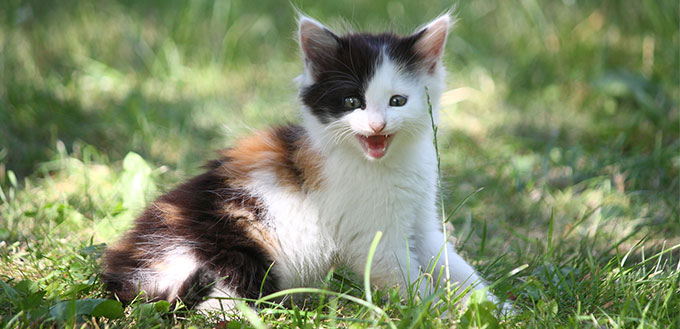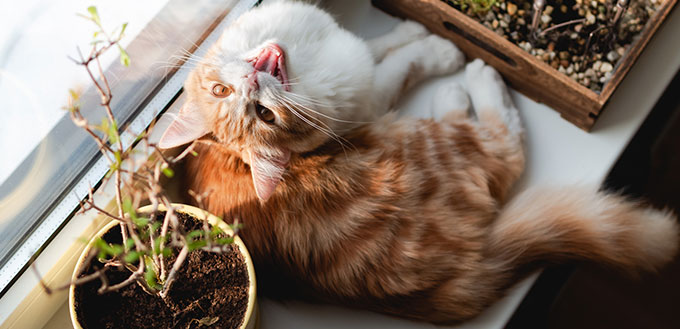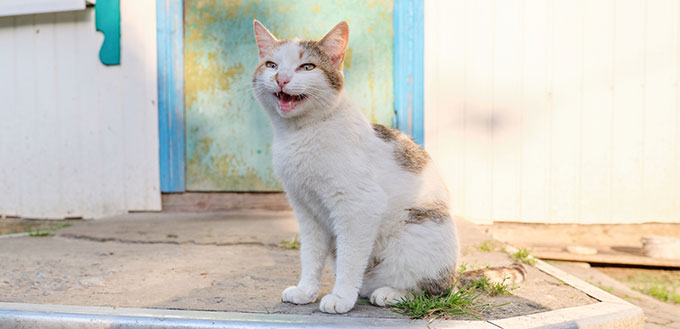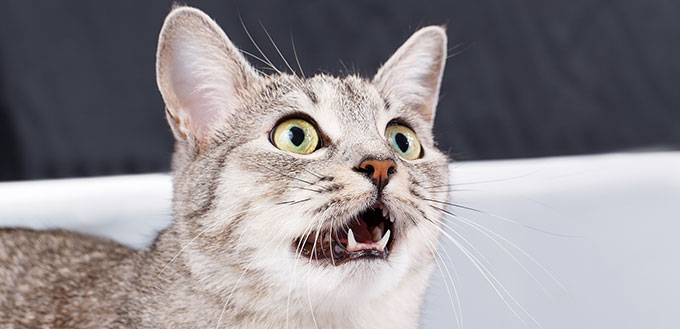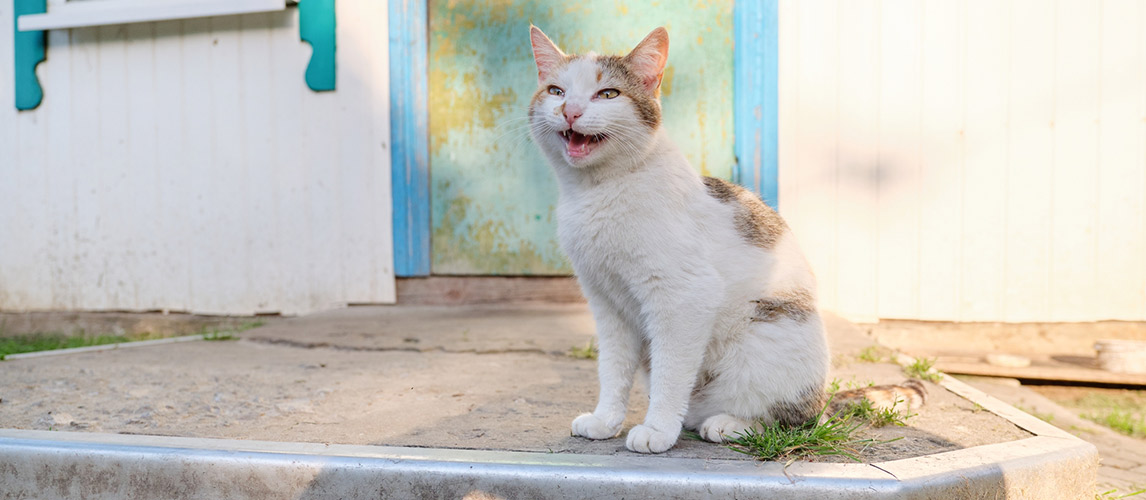What sound does a cat make? Sure, it’s a ‘meow’, but is a ‘meow’, ever just a ‘meow’? No doubt, this is a common question asked by many cat owners. It’s important to note that every feline out there emits different sounds, from the meows to growls and purrs. Also, there are certain cats that are a bit more vocal than the rest.
No doubt, age also has a role to play in the frequency of feline sound, for instance, newborn kittens are expected to be more communicative compared to older cats. Again, the level of vocalization among feral cats is not the same as domesticated kitties. Findings have shown that there are breeds of cats that are more likely to vocalize than the others, though the sounds cats make varies from one kitty to the other. So, if you are curious about cat sounds and what they mean, read on to get more fun and useful tidbits.
Meowing
According to children’s storybooks, meowing is the only sound cats make, but this is far from the truth, though it is regarded as the quintessential feline sound. Cat meowing comes in different forms, and cat parents will attest to the fact that all meows are not equal. From the way your furbaby is meowing, you will be able to determine if it is angry, content, or needs something like attention or food.
Although adult cats mew occasionally, it is the kittens that are more likely to meow a whole lot sound since they are born blind and deaf. As a result, they meow to get their mother’s attention. Furthermore, as young cats mature, they are expected to quit making this sound as a means of communication. However, there are still adult domestic kitties that meow, but it has been observed that they only do so when their human family members are present. They just do it to get attention – you know how cats get.
Purr
Just like meowing, purring is among the most common cat vocalizations. Conceivably the most mesmerizing and pleasurable of all feline sounds; it is realized as a deep, soft, throaty rumble, often emitted when your four-legged friend is in its best mood. So, basically when they are happy, content, or relaxed. Petting your furry friend tenderly as it sits on your lap is one sure way to spur this soothing sound of sheer contentment.
Apart from signaling a happy mood, feline purr can also mean several other things – a cat purrs when it feels threatened or frightened. On very rare occasions, a feline might resort to purring to show that it is agitated over a situation or something. This kind of sound is akin to the one humans make when they are nervous. This “worry-purr” can be discerned through body language. The cat will suddenly go tense with ears laid back, denoting its concern over a situation.
According to findings, cats also purr as a way of self-healing – they start purring to console themselves when they are maimed or when they have some form of health issues. Also, the auditory regularity of their purr, which occurs 25 cycles in a second, is believed to come with therapeutic properties, even acting as a form of internal massage.
Hiss
The intent of a kitty’s hiss cannot be mistaken as it is comparable to the sound emitted by a steak as it sizzles on the grill. However, a cat’s hiss can come out soft or loud, but this depends on the feline involved and the situation at hand. That loud hissing is a signal that your furry friend is threatened and poised to fight if the situation calls for it. More often than not, the hiss is a cat’s reaction to fear, which can be provoked by another feline, dogs, or humans. When a huge canine tries to get friendly with a cat, the situation is likely to provoke a loud hiss and even more.
Once a cat starts making these threatening sounds, there will be a change in its body language like puffed hair, arched back, flattened ears, twitchy tail, alongside an open mouth. In this situation, the feline will have its fangs poised and ready to hit the target. With a hissing cat, spitting is often expected, and once you observe your feline companion, display this serpent-like semblance, give it some space and do everything possible to get rid of the supposed threat.
Hissing is heavily dependent on a kitty’s perception, as well as its level of comfort. Some cats are more friendly and social, as such, they may never hiss. But the story is different with the reserved and shy ones that easily resort to hissing whenever they find themselves in uncertain situations. Another group of felines that are more likely to hiss are the stray, abused, and feral cats.
Yowl
The yowl is distinct from the logically happy sound of the meow as it comes longer and a bit more drawn-out. It denotes emotions like discomfort worry, mating issues, or territorial concern. Several other feline sounds are meant to reach out to humans, but the yowl is typical feline-to-feline communication. Most times it means, “you are encroaching on my territory” or “I am ready to mate.” This sound can also be emitted by a cat that is unwell; you can hear it when there is a decline in the senses or even cognitive functions.
Once your feline companion begins to yowl nonstop, it may be the right time to call on the vet as the sound may suggest a health problem. Your cat should be neutered immediately you take it home, especially if it’s an outdoor cat as you never can tell what he/she comes in contact with, in the great outdoors. Give your fur buddy enough attention and ample toys to play with. Sometimes, you only need to indulge your feline in extra playtime to put a stop to the yowling.
Growl
The growl is a plain angry sound from the depth of a cat’s stomach. Once you hear that guttural growl, it is an indication that all is not well in the cat’s world. It may be about something you have done or failed to do; a cat who gets treats often will take to growling when they have waited long enough. Don’t even try taking your chances with this kind of cat sound; it is quite serious.
Once the growls come rumbling out, it is meant to be a warning to the adopter. It is now your responsibility to find out what the problem is and fix it immediately. The growl can also come as a reaction to other cats, dogs, or humans. Some cats even resort to growling to establish their territory, in which case they could still make this sound out of anger or fear.
Chatter
Cat parents may have observed their feline friends looking out of the window staring at a squirrel or a sparrow. This kind of longing stare is usually accompanied by some sounds like a squeak, a chirp, or a faint cry. The feline chatter can also be realized as a combination of partial meows and tweets, signaling a plethora of emotions. The cat’s teeth are usually involved in the chattering sound, indicating its predatory enthusiasm as well as the anxiety at its inability to lynch the prey. Whenever you hear your kitty chatter, know that prey is lurking nearby, and your feline is anticipating the hunt. There is also this assumption that this fascinating vocalization is caused by a surge of adrenaline.
Burbling
The burbling sound is akin to chatter; however, it may not entail unrequited prey or hunt. This particular feline sound is best described as a hybrid sound since it’s a combination of some aspects of the meow, the purr, and the growl. When emitted, the burble doesn’t sound like the growl at all, as the vocalization is neither aggressive nor negative. What the sound generally suggests is that your fur baby is content, particularly when the sound is intended for the parent.
The Chirp
Compared to a normal feline meow, the chirp is a much more audibly-unique sound, realized as a short and high-pitched declaration. Your four-legged companion is only trying to get your attention when it chirps at you. Sometimes, a cat employs the chirping sound when they want their parents to investigate something they think is important or something cool. It is now your duty to try and decipher the meaning behind their cat’s chirp, for this, you only need to keep an eye on the feline’s behavior. If the chirp is just to get your attention, the cat will automatically seize all sounds once it catches your eye.
Caterwauling
The caterwauling noise is called the trademark sound of female kitties in heat. It is emitted as a drawn-out hollow-sounding yowl and functions as the perfect mating call of the female cat as designed by nature. The sound goes quite a long distance, attracting every male cat within the vicinity.
Trilling
Feline trilling is a sound between a purr and meow that cats employ as a welcoming greeting. It’s a common sound found in the slightly more attention loving and social cat breeds. On the flip side, cat breeds that are more reserved, shy or independent are less likely to make such sounds. Furthermore, cat mums also use this sound to get their kitty’s to pay them more attention.
Sources:
- Lynn Buzhardt, DVM, The Cat’s Meow! Caterwauling in Cats, VCA Hospitals
- Why Do Cats Purr?, WebMD
- Teresa Traverse, 8 Cat Sounds—And What They Mean, PetMD


